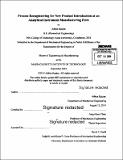| dc.contributor.advisor | Jung-Hoon Chun. | en_US |
| dc.contributor.author | Ranjan, Aditya | en_US |
| dc.contributor.other | Massachusetts Institute of Technology. Department of Mechanical Engineering. | en_US |
| dc.date.accessioned | 2015-02-05T18:29:18Z | |
| dc.date.available | 2015-02-05T18:29:18Z | |
| dc.date.copyright | 2014 | en_US |
| dc.date.issued | 2014 | en_US |
| dc.identifier.uri | http://hdl.handle.net/1721.1/93850 | |
| dc.description | Thesis: M. Eng. in Manufacturing, Massachusetts Institute of Technology, Department of Mechanical Engineering, 2014. | en_US |
| dc.description | Cataloged from PDF version of thesis. | en_US |
| dc.description | Includes bibliographical references (pages 107-111). | en_US |
| dc.description.abstract | The process of transforming Research and Development knowledge to successfully introducing new products in the market forms a key competency of an innovative company. This new product introduction process was studied at an analytical instrument manufacturing firm. The process of commercialization spanned a number of departments and the process flow lacked functional integration. The current introduction process also lacked a number of management processes, structured feedback loops for information transfer and data metrics for process assessment and evaluation. Due to this, the information related to product knowledge was lost in the process flow creating isolated compartments which was never shared in the process flow. It was also seen that problems created earlier in the process cascaded through the flow and an amplification effect of the problems was seen later. This combined with micro-management of key processes deliverables and inadequate documentation led to a phenomenon of 'firefighting' during the product introduction process. A new process was created for the creation of a Quality Inspection Plan, which was earlier missing. The two important deliverables were created as part of the process describing the critical dimensions and design tolerances of the new product. These documents were linked to the existing introduction process as a part of the phase gate review deliverables and would hence establish a structured method for information communication and feedback to Research and Development. These documents would also drive the creation of the Quality Inspection Plan by integrating downstream departments earlier in the process. Certain sub-process within the commercialization process were selected and the process was standardized for feedback- in terms of information as well as possible data base for metrics creation for continuous improvement initiatives. Also a set of recommendations were made to further strengthen and functionally integrate the process in order to reduce redundancies in the current commercialization process. | en_US |
| dc.description.statementofresponsibility | by Aditya Ranjan. | en_US |
| dc.format.extent | 111 pages | en_US |
| dc.language.iso | eng | en_US |
| dc.publisher | Massachusetts Institute of Technology | en_US |
| dc.rights | M.I.T. theses are protected by copyright. They may be viewed from this source for any purpose, but reproduction or distribution in any format is prohibited without written permission. See provided URL for inquiries about permission. | en_US |
| dc.rights.uri | http://dspace.mit.edu/handle/1721.1/7582 | en_US |
| dc.subject | Mechanical Engineering. | en_US |
| dc.title | Process reengineering for new product introduction at an analytical instrument manufacturing firm | en_US |
| dc.type | Thesis | en_US |
| dc.description.degree | M. Eng. in Manufacturing | en_US |
| dc.contributor.department | Massachusetts Institute of Technology. Department of Mechanical Engineering | |
| dc.identifier.oclc | 900980062 | en_US |
